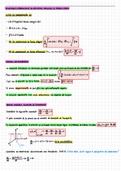ECUACIONES DIFERENCIALES ENDERIVADAS PARCIALES DE
PRIMERORDEN
CONSERVADON
LEYES DE AD
·
u(x.t) Magnitud(masa, energia etc.
·
p(x, t, u,u(...) Flujo
f(x, t, u) Fuentes
·
Let be conservacise forma integral
u(x.t)dx 8(x2 0/15
1)"20x
·
on =
-
20
Lex be conservacios forma diferencial (i.e., AX):
Gv(X,t) g
·
X2 x1
*
en + +
=
2/
ONDAS ESTACIONARIAS
La ecuacio's diferencial en derivadas parciales mas simple para una funcion de dos variables
es 0
=
t
Para resolverla integramos a ambos lados de la ecacion:
2u(s,y)ds u(t,t) u(0,4
= -
0
por esola solucion dela forma:u(t,x) f(x),
as conde
f(x) w(0.4)
= =
El lnico requerimiento es
que f(x) sea sufficientements regular.
La solucion representa una anda estacionaria (no depende del tiempol.
ONDAS VIAJERAS. ECUACION DETRANSPORTE
Considers la siguiente ecuacion:
Gu cayto +
Aesta ecuacion se la conoce can nombred ecuacion de transporte.
Es necesario especificar la solucion en untiempo inicial, dando lugar al problema devalores iniciales. ults, x) f(x)
=
&tCR
xU
u(t,y)
x(t)"du-2u+Oudoet
11x
x =
d* (t
=(t)
a
=
=
+
1 >
Curva caracteristic
LX (t k
+
considere unobservador describiendo una trajectoria (x (t), 4). Como varia what) segan la perspectiva del observator?
du du(x(t),t)
uxdy ut
=
=
dt dt
,dy c
=
ydy u++..
=
Por tanto las soluciones de la ecuacion de transporte son las mismas
que las del sistema de EDOs.
Ut (uX 0
+
=
dx 0
=
dt
⑤
u(t,y) f(X) =
du=o
Eiemple.
xU
+chy=
Gu 0;u(0,X) f(X
=
2t
u(t,y)
x(t)du-2u+Oudoet
11x
x = LX (t k
+
d* (t caracteristic
=(t)
u
a
=
=
1
+ >
Curva
f(x) w(0,X)
=
x(t) (t 11
= +
1(0) 5 = +
k7 5 =
↑ ↑
u(t,X(t)) k2u(0) f(s)
f(s) ke
=
=
= =
+
it
X(t,s) (t =
s
+
+
5 1 = -
ct
Yu(t, x) f(x (t)
=
ult,x) f(x ct.)
=
u(t,s) f(s);u(x,t)
f(x ct)
=
=
-
ECUACIONES CASI-LINEALES:METODO DE LAS CARACTERISTICAS
a(x,y,u)ux p(X,y,u)ay ((X,y,u)(I) +
=
15) (a,p,c).(ux,uy, 1)
+
= 0
Gualquier curva superficie S tiene vector tangente a (a,p,c)
has curvas caracteristicas satisfacen el signiente sistema:
EX a(x,y,u);d b(x,y,u);du can see
=
= -
La elacion (1) tiene condiciones iniciales:u/f(s), g(s)) h(s),
=
se
Entonces el sistema tiene condiciones iniciales:
1(0) 10(s,0)
=
=
f(s),y(0) y0(s.0) =g(s), =
w(0) 40(s,0) h(s)
=
=
, Ejemplo:
S.u u(X,y)
=
5:H(x,y,u) u(x,y)
=
-
u 0
=
dy ((X,y,u) u(t,s) 0
=
=
dy a(X,y,n) x(t,5) 0
=
=
dy=b(x,y,u) y(t,s) 0 =
y(0) X(s);y(0) y(s);u() u(s)
= = =
S:(X,y,u)(t,s)
METODO PARA RESOLVER LAS ECUACIONES CASILINEALES
DE LAGRANGE
Ejemploi
u,isent
1,ux x*7 yu
1
+
=
10(s) 8
=
tolst=s
no(s) sen(s)
u1o."1.
s
e
=
·
La solucion aparece de form a
(0-426
/4 (00*7c8R
7
( (, (1,1,u) x
-
=
11i
=
=
=
by X
=
implicita, como interseccion de dos
Dt
(* (2u*
du u
dly: /0u (0 4(0,4,u) = Superficies.In
=
su +
u
=
=
=
= ·
bt ↑
&
solucion general:FCP IFFFuncion = arbritarial sF( = =0 f(4242) ve*
= =
u(0,y) sen(y)= 5(4e(2) senye*;5(4)= seny
+
=
ne*k senle*(2):u(,1) eksenlie*2)
= =




